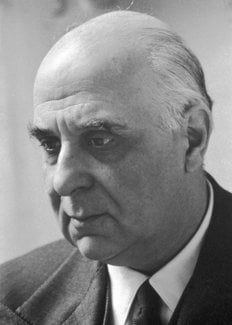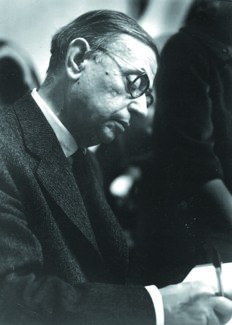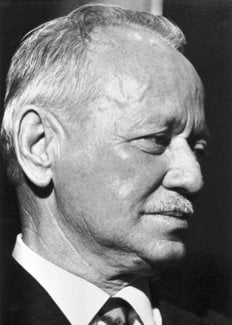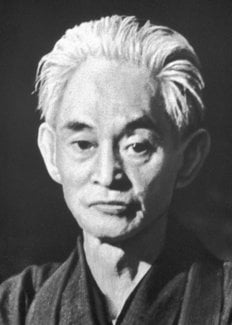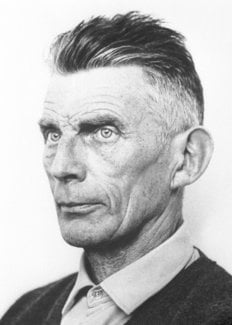The Nobel Prize in Literature 1961-1970
The Nobel Prize in Literature 1961
Ivo Andric “for the epic force with which he has traced themes and depicted human destinies drawn from the history of his country”.
The Nobel Prize in Literature 1962
John Steinbeck “for his realistic and imaginative writings, combining as they do sympathetic humour and keen social perception”.
———————————————————————————————————
The Nobel Prize in Literature 1963
Giorgos Seferis “for his eminent lyrical writing, inspired by a deep feeling for the Hellenic world of culture”.
Seferis was born in Smyrna, Asia Minor, in 1900. He attended school in Smyrna and finished his studies at the Gymnasium in Athens. When his family moved to Paris in 1918, Seferis studied law at the University of Paris and became interested in literature. He returned to Athens in 1925 and was admitted to the Royal Greek Ministry of Foreign Affairs in the following year. This was the beginning of a long and successful diplomatic career, during which he held posts in England (1931-1934) and Albania (1936-1938). During the Second World War, Seferis accompanied the Free Greek Government in exile to Crete, Egypt, South Africa, and Italy, and returned to liberated Athens in 1944. He continued to serve in the Ministry of Foreign Affairs and held diplomatic posts in Ankara (1948-1950) and London (1951-1953). He was appointed minister to Lebanon, Syria, Jordan, and Iraq (1953-1956), and was Royal Greek Ambassador to the United Kingdom from 1957 to 1961, the last post before his retirement in Athens. Seferis received many honours and prizes, among them honorary doctoral degrees from the universities of Cambridge (1960), Oxford (1964), Salonika (1964), and Princeton (1965).
His wide travels provide the backdrop and colour for much of Seferis’s writing, which is filled with the themes of alienation, wandering, and death. Seferis’s early poetry consists of Strophe (Turning Point), 1931, a group of rhymed Lyrics strongly influenced by the Symbolists, and E Sterna (The Cistern), 1932, conveying an image of man’s most deeply felt being which lies hidden from, and ignored by, the everyday world. His mature poetry, in which one senses an awareness of the presence of the past and particularly of Greece’s great past as related to her present, begins withMythistorema (Mythistorema), 1935, a series of twenty-four short poems which translate the Odyssean myths into modern idiom. In Tetradio Gymnasmaton (Book of Exercises), 1940,Emerologio Katastromatos (Logbook I), 1940, Emerologio Katastromatos B (Logbook II), 1944, Kihle(Thrush), 1947, and Emerologio Katastromatos C (Logbook III), 1955, Seferis is preoccupied with the themes he developed in Mythistorema, using Homer’s Odyssey as his symbolic source; however, in “The King of Asine” (in Logbook I), considered by many critics his finest poem, the source is a single reference in the Iliad to this all-but-forgotten king. The recent book of poetry,Tria Krypha Poiemata (Three Secret Poems), 1966, consists of twenty-eight short lyric pieces verging on the surrealistic.
In addition to poetry, Seferis has published a book of essays, Dokimes (Essays), 1962, translations of works by T.S. Eliot, and a collection of translations from American, English, and French poets entitled Antigrafes (Copies), 1965. Seferis’s collected poems (1924-1955) have appeared both in a Greek edition (Athens, 1965) and in an American one with translations en face (Princeton, 1967).
———————————————————————————————————
The Nobel Prize in Literature 1964
Jean-Paul Sartre “for his work which, rich in ideas and filled with the spirit of freedom and the quest for truth, has exerted a far-reaching influence on our age”.
ean-Paul Sartre, (1905-1980) born in Paris in 1905, studied at the École Normale Supérieure from 1924 to 1929 and became Professor of Philosophy at Le Havre in 1931. With the help of a stipend from the Institut Français he studied in Berlin (1932) the philosophies of Edmund Husserl and Martin Heidegger. After further teaching at Le Havre, and then in Laon, he taught at the Lycée Pasteur in Paris from 1937 to 1939. Since the end of the Second World War, Sartre has been living as an independent writer.
Sartre is one of those writers for whom a determined philosophical position is the centre of their artistic being. Although drawn from many sources, for example, Husserl’s idea of a free, fully intentional consciousness and Heidegger’s existentialism, the existentialism Sartre formulated and popularized is profoundly original. Its popularity and that of its author reached a climax in the forties, and Sartre’s theoretical writings as well as his novels and plays constitute one of the main inspirational sources of modern literature. In his philosophical view atheism is taken for granted; the “loss of God” is not mourned. Man is condemned to freedom, a freedom from all authority, which he may seek to evade, distort, and deny but which he will have to face if he is to become a moral being. The meaning of man’s life is not established before his existence. Once the terrible freedom is acknowledged, man has to make this meaning himself, has to commit himself to a role in this world, has to commit his freedom. And this attempt to make oneself is futile without the “solidarity” of others.
The conclusions a writer must draw from this position were set forth in “Qu’est-ce que la littérature?” (What Is Literature?), 1948: literature is no longer an activity for itself, nor primarily descriptive of characters and situations, but is concerned with human freedom and its (and the author’s) commitment. Literature is committed; artistic creation is a moral activity.
While the publication of his early, largely psychological studies, L’Imagination (1936), Esquisse d’une théorie des émotions (Outline of a Theory of the Emotions), 1939, and L’Imaginaire: psychologie phénoménologique de l’imagination (The Psychology of Imagination), 1940, remained relatively unnoticed, Sartre’s first novel, La Nausée (Nausea), 1938, and the collection of stories Le Mur (The Wall and other Stories), 1938, brought him immediate recognition and success. They dramatically express Sartre’s early existentialist themes of alienation and commitment, and of salvation through art.
His central philosophical work, L’Etre et le néant (Being and Nothingness), 1943, is a massive structuralization of his concept of being, from which much of modern existentialism derives. The existentialist humanism which Sartre propagates in his popular essay L’Existentialisme est un humanisme (Existentialism is a Humanism), 1946, can be glimpsed in the series of novels, Les Chemins de la Liberté (The Roads to Freedom), 1945-49.
Sartre is perhaps best known as a playwright. In Les Mouches (The Flies), 1943, the young killer’s committed freedom is pitted against the powerless Jupiter, while in Huis Clos (No Exit), 1947, hell emerges as the togetherness of people.
Sartre has engaged extensively in literary critisicm and has written studies on Baudelaire (1947) and Jean Genet (1952). A biography of his childhood, Les Mots (The Words), appeared in 1964.
———————————————————————————————————
Mikhail Aleksandrovich Sholokhov “for the artistic power and integrity with which, in his epic of the Don, he has given expression to a historic phase in the life of the Russian people”.
ikhail Aleksandrovich Sholokhov (1905-1984) was born in the land of the Cossacks, now known as the Kamenskaya region of the R.S.F.S.R. He attended several high schools until 1918. During the civil war he fought on the side of the revolutionaries, and in 1922 he moved to Moscow to become a journalist. There he published a number of short stories in newspapers. He made his literary debut in 1926 with a volume of stories, Donskie rasskazy (Tales from the Don), 1926, about the Cossacks of his native region, to which he had returned two years earlier.
In the same year, 1926, Sholokhov began writing Tikhi Don (And Quiet Flows the Don), 1928-1940, which matured slowly and took him fourteen years to complete. Reminiscent of Tolstoy in its vividly realistic scenes, its stark character descriptions and, above all, its vast panorama of the revolutionary period, Sholokhov’s epic became the most read work of Soviet fiction. Deeply interested in human destinies which are played against the background of the transformations and troubles in Russia, he unites in his work the artistic heritage of Tolstoy and Gogol with a new vision introduced into Russian literature by Maxim Gorky.
His other major work in the Don cycle, Podnyataya tselina (Virgin Soil Upturned), 1932 and 1959, deals in part with the collectivization of the Don area. There are a number of works such as the short story Sudba cheloveka (The Fate of a Man), 1957 – made into a popular Russian film – which treat the power and the resilience of human love under adversity. His collected works, Sobranie sochineny, were published in eight volumes between 1956 and 1960. In 1932 Sholokhov joined the Communist Party and, on several occasions, has been a delegate to the Supreme Soviets. In 1939 he became a member of the Soviet Academy of Sciences and later vice president of the Association of Soviet Writers.
The Nobel Prize in Literature 1966
Shmuel Yosef Agnon “for his profoundly characteristic narrative art with motifs from the life of the Jewish people”
Nelly Sachs“for her outstanding lyrical and dramatic writing, which interprets Israel’s destiny with touching strength”.
———————————————————————————————————
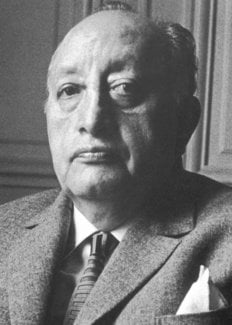
The Nobel Prize in Literature 1967
Miguel Angel Asturias “for his vivid literary achievement, deep-rooted in the national traits and traditions of Indian peoples of Latin America”.
iguel Angel Asturias (1899-1974) was born in Guatemala and spent his childhood and adolescence in his native country. He studied for his baccalaureate at the state high school and later took a law degree at the University of San Carlos. His thesis on “The Social Problem of the Indian” was published in 1923.
After he finished his law studies, he founded with fellow students the Popular University of Guatemala, whose aim was to offer courses to those who could not afford to attend the national university. In 1923 he left for Europe, intending to study political economy in England. He spent a few months in London and then went to Paris, where he was to stay for ten years. At the Sorbonne he attended the lectures on the religions of the Mayas by Professor Georges Raynaud, whose disciple he became. Also, as correspondent for several important Latin American newspapers, he travelled in all the Western European countries, in the Middle East, in Greece, and in Egypt.
In 1928 Asturias returned for a short time to Guatemala, where he lectured at the Popular University. These lecture were collected in a volume entitled La arquitectura de la vida nueva(Architecture of the New Life), 1928. He then went back to Paris, where he finished his Leyendas de Guatemala (Legends of Guatemala), 1930. Published in Madrid, the book was translated into French by Francis de Miomandre, who sent his translation to Paul Valéry. The French poet was greatly impressed, and his letter to Miomandre was used as the preface to the 1931 edition published in the Cahiers du Sud series. The same year, Leyendas de Guatemala received the Silla Monsegur Prize, a reward for the best Spanish-American book published in France.
During his stay in Paris from 1923 to 1933, Asturias wrote his novel El Señor Presidente (The President), which slashed at the social evil and malignant corruption to which an insensitive dictator dooms his people. Because of its political implications Asturias was unable to bring the book with him when, in 1933, he returned to Guatemala, which at the time was ruled by the dictator Jorge Ubico. The original version was to remain unpublished for thirteen years. The fall of Ubico’s regime in 1944 brought to the presidency Professor Juan José Arévalo, who immediately appointed Asturias cultural attaché to the Guatemalan Embassy in Mexico, where the first edition of El Señor Presidente appeared in 1946.
In late 1947, Asturias went to Argentina as cultural attaché to the Guatemalan Embassy and, two years later, obtained a ministerial post. While in Buenos Aires, he published Sien de alondra(Temple of the Lark), 1949, an anthology of his poems written between 1918 and 1948. In 1948 he returned to Guatemala for a few months, during which time he wrote his novel Viento fuerte(Strong Wind), 1950, an indictment of the effect of North American imperialism on the economic realities of his country. That same year, the second edition of El Señor Presidente was published in Buenos Aires.
When the government of President Jacobo Arbenz Guzman fell in 1954, Asturias went into exile in Argentina, his wife’s native country, where he remained until 1962. A year later, the Argentine publisher Losada brought out his novel Mulata de tal (Mulata). This story, a surrealistic blend of Indian legends, tells of a peasant whose greed and lust consign him to a dark belief in material power from which, Asturias warns us, there is only one hope for salvation: universal love.
In 1966 Asturias was awarded the Lenin Peace Prize. In the same year, he was appointed the Guatemalan ambassador to France by President Julio Mendez Montenegro.
———————————————————————————————————
The Nobel Prize in Literature 1968
Yasunari Kawabata “for his narrative mastery, which with great sensibility expresses the essence of the Japanese mind”.
Yasunari Kawabata, son of a highly-cultivated physician, was born in 1899 in Osaka. After the early death of his parents he was raised in the country by his maternal grandfather and attended the Japanese public school. From 1920 to 1924, Kawabata studied at the Tokyo Imperial University, where he received his degree. He was one of the founders of the publication Bungei Jidai, the medium of a new movement in modern Japanese literature. Kawabata made his debut as a writer with the short story, Izu dancer, published in 1927. After several distinguished works, the novel Snow Country in 1937 secured Kawabata’s position as one of the leading authors in Japan. In 1949, the publication of the serials Thousand Cranes and The Sound of the Mountain was commenced. He became a member of the Art Academy of Japan in 1953 and four years later he was appointed chairman of the P.E.N. Club of Japan. At several international congresses Kawabata was the Japanese delegate for this club. The Lake (1955), The Sleeping Beauty (1960) and The Old Capital (1962) belong to his later works, and of these novels, The Old Capital is the one that made the deepest impression in the author’s native country and abroad. In 1959, Kawabata received the Goethe-medal in Frankfurt.
Yasunari Kawabata died in 1972 (suicide).
———————————————————————————————————
The Nobel Prize in Literature 1969
Samuel Beckett “for his writing, which – in new forms for the novel and drama – in the destitution of modern man acquires its elevation”.
Bio-bibliographic information
| 1906 | Born in Dublin of Irish parents |
| 1927 | B.A. Trinity College, Dublin |
| 1928-29 | English reader at École Normale Supérieure, Paris |
| 1930 | French reader at Trinity College, Dublin |
| 1938 | Moved to France |
| 1945 | Began writing in French |
| 1989 | Died in Paris |
| Works in French | |
| 1951 | Molloy (novel) |
| 1951 | Malone Meurt (novel) |
| 1952 | En attendant Godot/Waiting for Godot (play in two acts) |
| 1953 | L’innommable/The Unnamable (novel) |
| 1955 | Nouvelles et Textes Pour Rien/Stories and Texts for Nothing |
| 1957 | Fin de Partie/Endgame (one-act play) followed by: Acte sans Paroles I/Act without Words I |
| 1961 | Comment C’est/How It Is (novel) |
| 1967 | Têtes Mortes (D’un ouvrage abandonné/From an Abandoned Work, Imagination Morte Imaginez/Imagination Dead Imagine, Bing/Ping) |
| 1970 | Premier amour/First Love (novel) |
| 1978 | Pas, suivi de Quatre Esquisses/Steps, followed by Four Sketches (plays) |
| 1979 | Poèmes/Poems |
| Works in English | |
| 1977 | Ends and Odds: Plays and Sketches |
| 1979 | All Strange Gone Away (short prose) |
| 1980 | Company (short prose) |
| 1980 | The Expelled and Other Novellas |
| 1981 | Rockaby and Other Pieces (plays and prose) |
| 1982 | Three Occasional Pieces (plays) |
| 1983 | Worstward Ho (short prose) |
| 1983 | Disjecta: Miscellaneous Writing and a Dramatic Fragment |
| 1984 | Collected Shorter Prose 1945-1980 |
| 1986 | Collected Poems 1930-1979 |
| 1989 | Nohow On (short stories) |
| 1990 | As the Story Was Told: Uncollected and Late Prose |
| French translations by the author | |
| 1953 | Murphy (novel) |
| 1957 | Tous Ceux qui Tombent/All that Fall (radio play) |
| 1960 | La dernière bande/Krapp’s Last Tape (one-act play) followed by Cendres/Embers (play) |
| 1963 | Oh Les Beaux Jours/Happy Days (play in two acts) |
| 1966 | Comédie et Actes Divers/Play and Sundry Acts (Comédie/Play, Va-et-Vient/ Come and Go, Cascando, Paroles et Musique/Words and Music, Dis Joe/Eh! Joe, Acte sans Paroles II/Act without Words II) |
| 1968 | Poèmes/Poems |
| 1969 | Watt (novel – translated by Ludovic and Agnès Janvier in collaboration with the author) |
| Works in English translated from French by the author | |
| 1972 | The Lost Ones (short prose) |
| 1973 | First Love (short prose) |
| 1974 | Mercier and Camier (novel) |
| 1975 | Malone Dies (novel) |
| 1975 | The Unnamable (novel) |
| 1976 | For to End Yet Again and Other Fizzles (short prose) |
| 1978 | Six Residua (short prose) |
| 1982 | Ill Seen, Ill Said |
Samuel Beckett died on 22 December 1989.
———————————————————————————————————
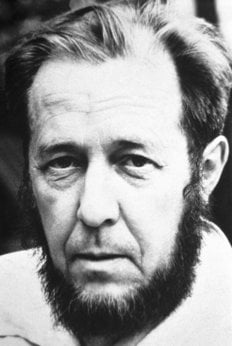
The Nobel Prize in Literature 1970
Aleksandr Isayevich Solzhenitsyn “for the ethical force with which he has pursued the indispensable traditions of Russian literature”.
I was born at Kislovodsk on 11th December, 1918. My father had studied philological subjects at Moscow University, but did not complete his studies, as he enlisted as a volunteer when war broke out in 1914. He became an artillery officer on the German front, fought throughout the war and died in the summer of 1918, six months before I was born. I was brought up by my mother, who worked as a shorthand-typist, in the town of Rostov on the Don, where I spent the whole of my childhood and youth, leaving the grammar school there in 1936. Even as a child, without any prompting from others, I wanted to be a writer and, indeed, I turned out a good deal of the usual juvenilia. In the 1930s, I tried to get my writings published but I could not find anyone willing to accept my manuscripts. I wanted to acquire a literary education, but in Rostov such an education that would suit my wishes was not to be obtained. To move to Moscow was not possible, partly because my mother was alone and in poor health, and partly because of our modest circumstances. I therefore began to study at the Department of Mathematics at Rostov University, where it proved that I had considerable aptitude for mathematics. But although I found it easy to learn this subject, I did not feel that I wished to devote my whole life to it. Nevertheless, it was to play a beneficial role in my destiny later on, and on at least two occasions, it rescued me from death. For I would probably not have survived the eight years in camps if I had not, as a mathematician, been transferred to a so-called sharashia, where I spent four years; and later, during my exile, I was allowed to teach mathematics and physics, which helped to ease my existence and made it possible for me to write. If I had had a literary education it is quite likely that I should not have survived these ordeals but would instead have been subjected to even greater pressures. Later on, it is true, I began to get some literary education as well; this was from 1939 to 1941, during which time, along with university studies in physics and mathematics, I also studied by correspondence at the Institute of History, Philosophy and Literature in Moscow.
In 1941, a few days before the outbreak of the war, I graduated from the Department of Physics and Mathematics at Rostov University. At the beginning of the war, owing to weak health, I was detailed to serve as a driver of horsedrawn vehicles during the winter of 1941-1942. Later, because of my mathematical knowledge, I was transferred to an artillery school, from which, after a crash course, I passed out in November 1942. Immediately after this I was put in command of an artillery-position-finding company, and in this capacity, served, without a break, right in the front line until I was arrested in February 1945. This happened in East Prussia, a region which is linked with my destiny in a remarkable way. As early as 1937, as a first-year student, I chose to write a descriptive essay on “The Samsonov Disaster” of 1914 in East Prussia and studied material on this; and in 1945 I myself went to this area (at the time of writing, autumn 1970, the book August 1914 has just been completed).
I was arrested on the grounds of what the censorship had found during the years 1944-45 in my correspondence with a school friend, mainly because of certain disrespectful remarks about Stalin, although we referred to him in disguised terms. As a further basis for the “charge”, there were used the drafts of stories and reflections which had been found in my map case. These, however, were not sufficient for a “prosecution”, and in July 1945 I was “sentenced” in my absence, in accordance with a procedure then frequently applied, after a resolution by the OSO (the Special Committee of the NKVD), to eight years in a detention camp (at that time this was considered a mild sentence).
I served the first part of my sentence in several correctional work camps of mixed types (this kind of camp is described in the play, The Tenderfoot and the Tramp). In 1946, as a mathematician, I was transferred to the group of scientific research institutes of the MVD-MOB (Ministry of Internal Affairs, Ministry of State Security). I spent the middle period of my sentence in such “SPECIAL PRISONS” (The First Circle). In 1950 I was sent to the newly established “Special Camps” which were intended only for political prisoners. In such a camp in the town of Ekibastuz in Kazakhstan (One Day in the Life of Ivan Denisovich), I worked as a miner, a bricklayer, and a foundryman. There I contracted a tumour which was operated on, but the condition was not cured (its character was not established until later on).
One month after I had served the full term of my eight-year sentence, there came, without any new judgement and even without a “resolution from the OSO”, an administrative decision to the effect that I was not to be released but EXILED FOR LIFE to Kok-Terek (southern Kazakhstan). This measure was not directed specially against me, but was a very usual procedure at that time. I served this exile from March 1953 (on March 5th, when Stalin’s death was made public, I was allowed for the first time to go out without an escort) until June 1956. Here my cancer had developed rapidly, and at the end of 1953, I was very near death. I was unable to eat, I could not sleep and was severely affected by the poisons from the tumour. However, I was able to go to a cancer clinic at Tashkent, where, during 1954, I was cured (The Cancer Ward, Right Hand). During all the years of exile, I taught mathematics and physics in a primary school and during my hard and lonely existence I wrote prose in secret (in the camp I could only write down poetry from memory). I managed, however, to keep what I had written, and to take it with me to the European part of the country, where, in the same way, I continued, as far as the outer world was concerned, to occupy myself with teaching and, in secret, to devote myself to writing, at first in the Vladimir district (Matryona’s Farm) and afterwards in Ryazan.
During all the years until 1961, not only was I convinced that I should never see a single line of mine in print in my lifetime, but, also, I scarcely dared allow any of my close acquaintances to read anything I had written because I feared that this would become known. Finally, at the age of 42, this secret authorship began to wear me down. The most difficult thing of all to bear was that I could not get my works judged by people with literary training. In 1961, after the 22nd Congress of the U.S.S.R. Communist Party and Tvardovsky’s speech at this, I decided to emerge and to offerOne Day in the Life of Ivan Denisovich.
Such an emergence seemed, then, to me, and not without reason, to be very risky because it might lead to the loss of my manuscripts, and to my own destruction. But, on that occasion, things turned out successfully, and after protracted efforts, A.T. Tvardovsky was able to print my novel one year later. The printing of my work was, however, stopped almost immediately and the authorities stopped both my plays and (in 1964) the novel, The First Circle, which, in 1965, was seized together with my papers from the past years. During these months it seemed to me that I had committed an unpardonable mistake by revealing my work prematurely and that because of this I should not be able to carry it to a conclusion.
It is almost always impossible to evaluate at the time events which you have already experienced, and to understand their meaning with the guidance of their effects. All the more unpredictable and surprising to us will be the course of future events.
